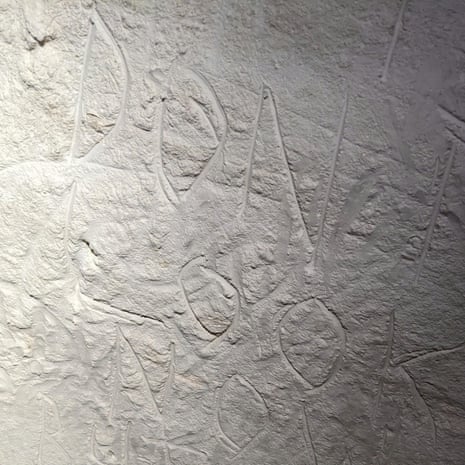Vandals have destroyed a 30,000-year-old artwork at a sacred cave in South Australia, as experts decried the “massive, tragic loss” and expressed frustration at the lack of protection at the site.
The vandals entered Koonalda Cave at Nullarbor Plain and scrawled graffiti across the heritage-listed site, writing “don’t look now, but this is a death cave”.
Authorities say the vandals dug under a steel gate to gain access to the site and completely destroyed one area of it.
Dr Keryn Walshe, an archaeologist specialising in ancient Aboriginal sites, said the artwork was “unique in Australia” and had been registered as a national heritage site because of its rarity.
“The vandals caused a huge amount of damage. The art is not recoverable,” she said.
“The surface of the cave is very soft. It is not possible to remove the graffiti without destroying the art underneath. It’s a massive, tragic loss to have it defaced to this degree.”
Walshe said the art was “very significant” to the traditional owners, the Mirning people, who have been visiting the cave for more than 30,000 years.
She added that the fence, which was installed in the 1980s, had become “inadequate” over time, with many people previously gaining access and writing their names or dates in the cave.
A spokesperson for the SA government said the vandalism was “shocking and heartbreaking”.
“If these vandals can be apprehended they should face the full force of the law,” the spokesperson said.
“Over recent months, the South Australian government has been consulting Traditional Owners and other stakeholders on developing a comprehensive plan to better protect this important site.
“The existing fencing and general difficulty in accessing the caves deters the vast majority of visitors from trespassing. Live monitoring of the site via closed circuit cameras is being considered to better protect the cave.”
Kyam Maher, the SA attorney general and minister for Aboriginal affairs, condemned the vandalism and called for a “severe penalty” to be imposed.
“It is a shocking thing,” he told ABC Radio.
“From what I’ve been told and shown photos, on the very soft rock inside the cave, the vandals … used their finger and drawn on top of very old art work.”
But Maher has been criticised by experts, who say they informed the government of the vandalism in June, and that little had been done to improve security around the site since.
Dr Clare Buswell, chair of the Australian Speleological Federation’s Conservation Commission, raised the vandalism in a submission to the Aboriginal lands parliamentary standing committee in July.
after newsletter promotion
In her submission, she said both SA’s Aboriginal Heritage Act and the Aboriginal affairs and reconciliation arm of the Attorney General’s Department had failed to protect the site.
“The failure to build an effective gate, or to make use of modern security services, such as wildlife monitoring cameras that operate 24/7, has in many ways, allowed this vandalism to occur,” Buswell wrote in her submission.
‘This is about beefing up security’
Buswell told Guardian Australia that the state government needed to be pressured into action or more of the artwork could be lost to vandals.
“It was wilful, deeply incised, damaging the art, and nothing has been done since to protect the site. So this could continue until some protection is installed,” she said.
“It’s simply not good enough for the minister to say, oh, we’ll just increase the amount of fines or other punitive actions. That’s not what this is about. This is about beefing up security.”
The SA Attorney General’s Department and the Department for Environment and Water have been contacted for comment.
The cave was listed in 2014 as a national heritage site, and is managed by the Department for Environment and Water and the Far West Coast Aboriginal Corporation, of which the Mirning people are a part.
But while the Mirning people have ownership of the cave, they are prevented from properly protecting it because the state’s Aboriginal Heritage Act preceded the federal Native Title Act of 1993.
The state act has never been changed to recognise the federal legislation that empowers native title holders.
